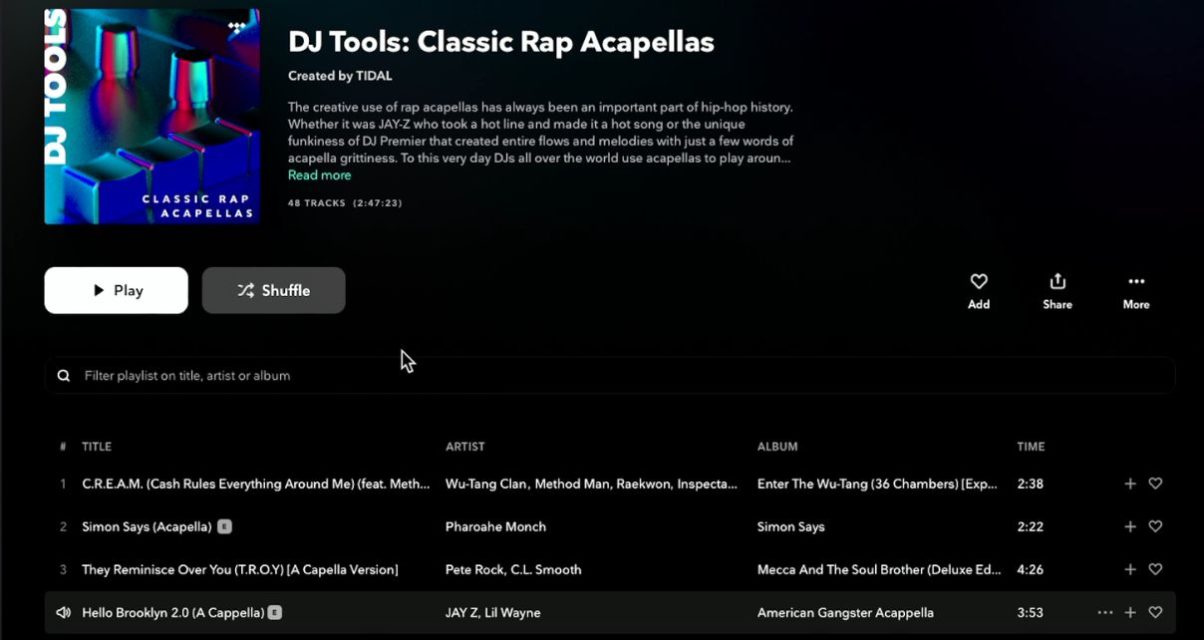Tidal has restricted Stems within all DJ software as of 1 October. That means when you’re using Tidal to play music in your DJ software, the stems functions will no longer work, whether your software is Serato, Rekordbox, djay Pro AI, Engine DJ, or any of the nine platforms it integrates with.
We’re currently getting reports from users of most platforms that this has happened, and we have no doubt that this will affect all platforms on their next software update.
What can Tidal stems DJs do?
Short term – don’t update your DJ software. We know people who haven’t updated Algoriddim’s djay software for years, to keep the old Spotify integration!
Longer term: Buy the tracks you want to use the acapellas and stems of in your DJ software. The real-time stems functions will still work on music you own, or for best results you can use software to prep stems ahead of time, which is what pro DJs do anyway – Ultimate Vocal Removal is for Mac, Windows and Linux and is open source (and sounds amazing), and RipX is a massively flexible paid-for alternative.

Oh, and there are still actual DJ acapellas on Tidal – they’re obviously not affected. So search for “DJ acapella” or “acapella” and see what you find!
Read this next: Where DJs Get Acapellas
Why has this happened?
Major labels probably feel having stems in DJ software is overstepping the mark. You can be sure many of their artists don’t like it. While Tidal is enforcing this, it is not going to have been Tidal’s decision.
We think that major labels may feel the whole mashup thing is so big they have to control it. They can do that on TikTok, because they’re in cahoots with that platform – but DJs are renegades, we take the tracks and run, and we are guessing the labels ultimately have decided they want to make that harder for us.
What might happen next?
Your DJ software may force an update – a rare case where updating your software to the latest version will remove features. This is unlikely, but who knows?
We also think that stems will get pulled from other major label streaming services, for instance Beatsource and Amazon – although Amazon may push back, like they did and do on Twitch when it comes to DJ streaming (Amazon owns Twitch).
Learn to DJ with acapellas and stems the RIGHT way
Does this mean stems DJing is dead? Far from it – using acapellas and stems is one of the best ways of standing out and showing your skill as a DJ. Learn how it’s done properly with the Digital DJ Tips course, “How To DJ With Acapellas (& Stems)”. Click here to find out more.
Looking further ahead, some streaming services may even choose to withdraw from DJ platforms altogether, if this is just the start and the tide (no pun intended) moves against DJs being able to use tracks as raw materials so easily. After all, there is a reason why the really big companies, ie Spotify and Apple Music, aren’t in DJ software – they may have foreseen this pushback from the labels.
Manage your DJ collection like a pro: The Complete DJ Course
One bit of good news: We’ve heard from a trusted source that while Tidal has pulled stems functionality, it will allow DJ software to offer an offline locker of cached tracks for the first time, and that at least one major platform will be implementing this.
Our thoughts
Mashups, acapellas and bootlegs have always been a murky world. When you sign up to a streaming service, you get the rights to temporarily play versions of music that they have on their platforms. That’s why you’re not allowed to record when using streaming.
Looked at from that angle, even the fact that it’s been possible to use stems with streaming services up till now was probably just luck.
As ever, our view as a DJ school is that streaming is great for discovery and messing around, but buy the songs you want. If you’re going to separate them into acapellas and other stems, ethically you should own the tracks anyway. This decision gives you just one more reason to build a real music collection that nobody can touch!



